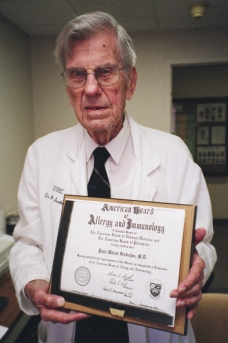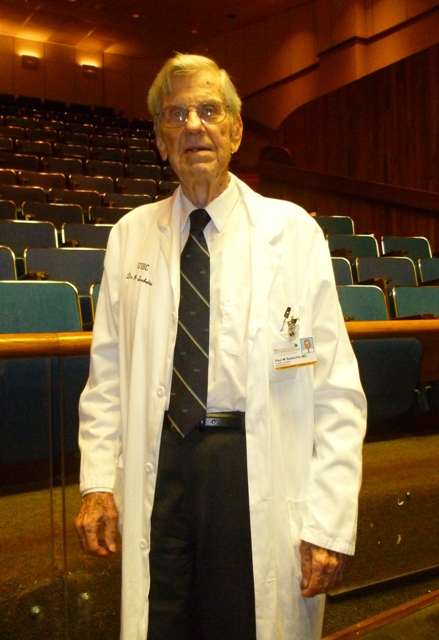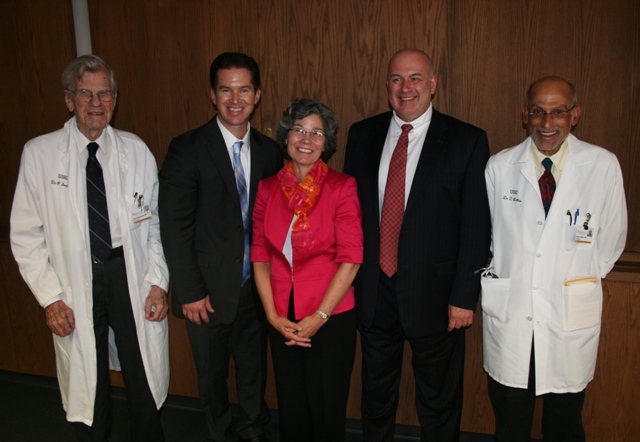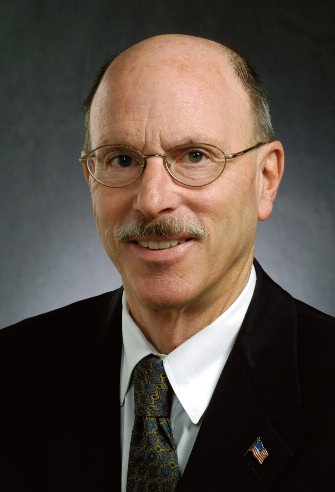ABAI's First Board Certified Diplomate,
Paul M. Seebohm, MD —
Staying Current at 95
A & I pioneer, leader and perennial MOC participant
by Will Thompson, MS
Tucked quietly amid the commotion of Kinnick Stadium — "Hawkeye" football — and roar of crowds where wrestling reigns supreme is the University of Iowa Carver College of Medicine. Decades before the great "Big-10" Rose Bowl teams of Hayden Fry and legend of all-world grappler/coach Dan Gable, a pioneer in Allergy and Immunology (A & I) emerged on the Iowa campus. Now, in his 96th year, Paul M. Seebohm, MD, Professor Emeritus in the Department of Internal Medicine, has not only outlasted the careers of the aforementioned icons, he continues to dedicate himself to the specialty which he has played a significant role in shaping over the last 70 years.

Dr. Seebohm has the distinction of being awarded ABAI certificate number 1. He is also a current participant in the ABAI MOC program.
(Photo by: Will Thompson)
On this occasion, ABAI staff traveled to Iowa City, IA, to meet ABAI's first Board Certified Diplomate and one of the organization's founders for just another day at the office. Seebohm, who multiple times throughout our visit underscored the fundamental necessity for Continuing Medical Education (CME) and staying current in the specialty, also continues to attend grand rounds each week in the original amphitheatre which is surrounded by the modern expansion of the UI Carver College of Medicine that he helped to facilitate after his retirement.
Since his "retirement" and prompt un-retirement at age 70, Seebohm has spent much of his golden years as a 'real time' living legacy and ambassador for A & I, serving as a consultant to the dean and for playing an instrumental role in the physical growth of the Eckstein Medical Research Building and the College of Medicine Administration Building.
As an administrator, he was named associate dean in 1970 and executive associate dean in 1974, until retirement in 1986. During his tenure, he established the Office of Community Programs, was President of the Iowa State Board of Health, President of the Iowa Medical Society, and has championed medical education, professionalism and public health needs statewide.
Early years of A & I
It was a local and systemic reaction to a skin test dose of horse serum in a YMCA camper who stepped on a rusty nail that provided the 20-year-old "camp doctor" with his first foray into the world of allergy. During the summer after Seebohm's sophomore year at Oberlin College, the Ohio native curiously observed the camper's sneezing, swelling and hives minutes after a skin test with anti-tetanus vaccine. "I had to administer adrenaline injections throughout the night at two-hour intervals until the town doctor had the boy admitted to the town hospital. Up to this point, I had just taken care of cuts and scrapes," said Seebohm.
However, it would be subsequent brushes with the immune response in the years to come for the 1941 University of Cincinnati College of Medicine grad to link and become intrigued by clinical manifestations that strangely seemed to fall outside the realm of general practice and the established specialties of the time. World War II broke out while Seebohm was completing his internship at Wisconsin General Hospital, Madison, WI, which was followed by a four-year stint as a U.S. Army Air Force flight surgeon. While stationed in Pratt, Kansas, he shares, "We were getting a group of B-29 bombers and crews ready to depart for the Japanese campaign, when we received last minute orders to give the vaccine for typhus and cholera. After we vaccinated several thousand soldiers, one complained his asthma had been made worse, and by the time our ambulance arrived at his barracks he had died. Post-mortem enquiry revealed he was exquisitely sensitive to egg protein and the vaccine had been raised on egg embryos. This impressed upon me that there really is something to allergy."
His career turning point came after the war — while in residency at Cincinnati General Hospital (1946-48) — when a wave of asthmatics showed up at the receiving room late each evening. "We got the attack over with, sent them home, and then saw some of the same people the next night." His fascination with this, led the inquisitive Seebohm to ask the question "what do you do about this asthma?" A colleague suggested it might be allergy, but Seebohm hadn't had any allergy training or lectures in medical school, nor had Cincinnati General's allergist returned from WWII. A staff cardiologist told Seebohm that he sent all of his asthmatics to the Robert A. Cooke Institute at Roosevelt Hospital in New York City because "Cooke was one of the founders of American allergy." Seebohm then went on to complete his fellowship studying under the country's foremost allergist before landing a faculty position at Iowa in 1949. He rose to full professor in 1959, and was director of the new Allergy Section which formed upon his arrival.
On Board Certification and Quality Improvement
Before the days of worldwide testing sites, computer-based testing, hundreds of questions, fingerprinting, palm vein scanning, photo IDs, and a host of other stringent electronic security measures, Seebohm and colleagues would test each other’s knowledge face to face. "The original certification exam was put together the day before it was given. It had two parts; the first was a series of questions covering fundamental topics 'T-cells and B-cells' followed by part II which was a collection of pollen slides to be identified."


Dr. Seebohm in the Medical Alumni Auditorium where he attends grand rounds each week.
(Photo by: Will Thompson)
As an ambassador in the dual role as President of the American Academy of Allergy & Immunology (AAAI), forerunner of the American Academy of Allergy, Asthma & Immunology (AAAAI), Seebohm was instrumental in taking the fledgling A & I discipline from what was largely considered a loose collection of psychosomatic disorders to specialty status and ultimately acceptance, and board certification played a significant part in this. "Around the mid-fifties, my AAAI counterpart, John Vaughn, MD, Chair of the Sub board of Allergy, and I asked the question: why doesn't allergy have better status in the academic institutions. So we made the decision to hold the examination in the medical center. When we conducted exams at Iowa, examiners and examinees would assemble. Maybe a half dozen would be taking the exam and many times you knew everyone anyway."
Seebohm along with Ken Matthews, MD, of the University of Michigan conducted a study through the AAAI in 1951 on a sample of training programs that had allergy training and lecture and those that did not. "We had these different programs administer the same exam which showed that those having lecture and training in allergy did measurably better—this is the same quality improvement concept that you're talking about today, just 60 years ago."
His take on ABAI's current content classification outline and blueprint for topic coverage on the 2011 exams, "overwhelming," he laughs, "but there are many topics on the list that have been standard for years, and keep in mind, the current list also takes into consideration all of immunology."
ABAI
Seebohm was a key catalyst in the inception and approval of ABAI when it became a new ABMS specialty board in 1971. He played important roles in the development and proceedings that granted ABAI its conjoint board status with American Board of Internal Medicine (ABIM) and American Board of Pediatrics (ABP). According to: The American Board of Allergy and Immunology: The First Twenty-Five Years, a commemorative volume wrote and edited, in part, by Seebohm, the account of the conjoint boards' inaugural meeting in Chicago on December 11, 1971 reads:
"It was with considerable pride and pleasure that the Board voted to award Certificate Number 1 to Paul M. Seebohm for his outstanding efforts in the formation of the new board."

Dr. Seebohm, ABAI's first diplomate, was honored in June by ABAI staff and UI colleagues. From left: Paul M. Seebohm, MD, Will Thompson, MS (ABAI Manager of Test Development), Mary Beth Fasano, MD, MSPH (Clinical Professor, Director, Allergy-Immunology Fellowship Program, UI Department of Internal Medicine, and current ABAI Director and Vice Chair), Larry Vapniarek, MBA (ABAI COO), and Zuhair K. Ballas, MD (Professor, Director, Division of Immunology, UI Department of Internal Medicine, and former ABAI Director and Chair).
(Photo by: Bill Radl, University of Iowa)
He underscored the importance of certification and the work of the ABAI, offering some advice for physicians in 2011. "Keeping current is paramount," says Seebohm reiterating that CME is the most important aspect of effective education and practice; he advises fellows and residents to "stay up-to-date throughout their careers, and to play a role in a national professional society, in this case, getting involved with the Academy." To reinforce his philosophy, Seebohm stays current by maintaining the required annual MOC components in ABAI's Web Portal while participating in their MOC activities.
Longevity, Golf and "Retirement"
Seebohm left teaching and seeing patients years ago, but continues to keep his state license current. In order for an allergy program to always remain at The University of Iowa, in 1993, an endowment was founded by Paul and his wife Dorothy to support an annual Visiting Professorship and Travel Fellowships for residents to attend Academy and College meetings.
Golf was always a constant for Seebohm and colleagues at UI's Finkbine Golf Course, and talk of current PGA players and stats readily rolls off his tongue when on the subject. "My golfing career was always up and down, but I got on a roll when I hit 70; and at 75, I 'holed' the par 3 Hole #4 with a hole-in-one—it was a 5-iron."
Seebohm, who will be 96 this January, drives the commute to UI daily, crossing the Iowa River that divides the beautiful downtown campus. On his secret to longevity, he said, "I really don’t know— I've just been very fortunate to be able to stay involved and work with such a great group of people." He added, "I don't like to brag, but I've never been in this hospital overnight (as a patient)". He also joked that he still keeps regular office hours "because they provide parking and the lunches here are great!"


